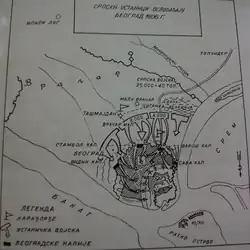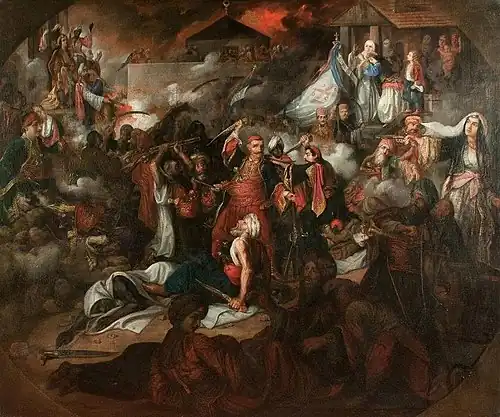Siege of Belgrade (1806)
| Siege of Belgrade (1806) | |||||||
|---|---|---|---|---|---|---|---|
| Part of the First Serbian Uprising | |||||||
 The death of Vasa Čarapić at the Stambol Gate | |||||||
| |||||||
| Belligerents | |||||||
|
| |||||||
| Commanders and leaders | |||||||
| Units involved | |||||||
|
|
| ||||||
| Strength | |||||||
|
12,000–25,000 40 cannons | 300 cannons | ||||||
| Casualties and losses | |||||||
| 50 dead, 60 wounded | Around 300 dead, many captured | ||||||
The Siege of Belgrade (Serbian: Опсада Београда, romanized: Opsada Beograda) was carried out by the Serbian rebels led by Karađorđe, seeking to overthrow the Ottoman government in the Sanjak of Smederevo, which was seated in the Belgrade Fortress. Following the victories at Mišar (13–15 August) and Deligrad (3 September), the Serbian rebels marched towards Belgrade.
Belgrade was in Serbian hands by 26 December 1806.[1]
The battle
The plan of penetrating the town of Belgrade, through taking over the Sava, Varoš, Stambol and Vidin Gate), was presented by Konda Bimbaša to Karađorđe. Konda Bimbaša, well aware of the operating procedures of the Ottoman guard, took the leadership over volunteers to take over the Sava gate, accompanied by Uzun-Mirko. Karađorđe decided with the commanders that the attack be carried out on Saint Andrew's Day, during Eid al-Fitr, when the attention of the guards was lower. Rebel columns were set on each gate, to storm after the gate was taken, commanded by Milivoje Petrović Blaznavac, Sima Marković, Vasa Čarapić, Stanoje Glavaš and Vule Ilić. At the estimated time, Konda, Uzun-Mirko, Petar Sremac, Nikola Stambolija, Karlovalija, Dragić, and Mladen headed out, followed by a detachment of volunteers, and then the main column of Miloje Petrović. Since they arrived unnoticed at the gate, Konda and Uzun-Mirko first climbed the rampart and jumped over the palisade, and headed towards the guards on a bypassing road. Met by an Ottoman patrol, they presented themselves as kirdzhalis, then proceeded to the town gates and guards where they divided into two groups. Uzun-Mirko and Konda attacked the guards, and the rest broke into the gate locks with axes. In the fight, Uzun-Mirko received two wounds, and Konda five, but they kept on. Even though shots were fired, the Turks in the town and at the rest of the gates did not suspect that a Serbian attack was in question, but that shots were fired for the holiday. After taking over the first gates, commandos went toward the Varoš Gate, at which time the Turks were alarmed. Most of the Turks tried to reach the Upper Fortress (Kalemegdan), while the resistance was provided by the so-called krdžalije. Uzun-Mirko and Konda also fought on the Varoš Gate, while Vasa Čarapić died taking over the Stambol Gate, and Stanoje Glavaš and Vule Ilić penetrated through the Vidin Gate, after which the rebels easily took over the town towards Kalemegdan.[2]
Aftermath
In January 1807, the Ottomans accepted "Ičko's Peace", however, the rebels rejected it and sought Russian aid to their independence, signing a Russian-Serbian military alliance in June.
Gallery
-
 Attack plan
Attack plan -

-
References
- ^ Radosavljević & Marinković 2012, p. 284.
- ^ Kosta Protić (1893). Ratni događaji iz Prvog srpskog ustanka 1804—1813 pod voždom Karađorđem Petrovićem. Beograd: Publisher unknown.
Sources
- Radosavljević, Nedeljko V.; Marinković, Mirjana O. (2012). "Једна османска наредба о војном уништењу Србије из 1807. године" [An Ottoman order on the military destruction of Serbia from 1807]. Истраживања. 23: 283–293.
- Ћоровић, Владимир (2003). Карађорђе и први српски устанак [Karađorđe in the First Serbian Uprising] (in Serbian). Београд: Свет књиге. ISBN 978-86-7396-057-9.
- Ljušić, Radoš (2000). Vožd Karađorđe (in Serbian). Vol. 1 (2nd ed.). Belgrade: Udruženje za srpsku povesnicu.
- Morison, W. A. (2012) [1942]. The Revolt of the Serbs Against the Turks: (1804-1813). Cambridge University Press. ISBN 978-1-107-67606-0.
Further reading
- Tošković, J. (1930) O padu Beograda i Šapca, 26. decembra 1806. 26. januara 1807. god. Beograd
External links
- Timotijević, Miroslav. "Memorijal oslobodiocima Beograda 1806" (PDF) (in Serbian).